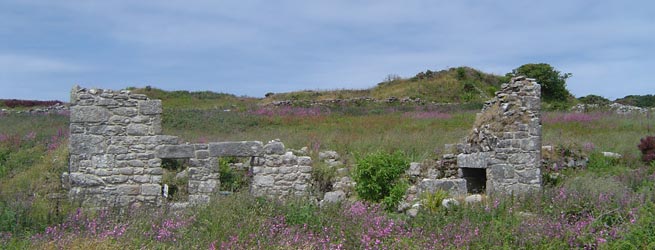Background
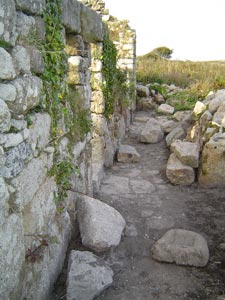
Count House and Cottage, south elevation
The Count House is an important historic building that has generally escaped recognition for its contribution to the mining history of Cornwall and to the Industrial Revolution in England. This building is the former Count (Account) House of the great Cornish engineer, Richard Trevithick, during his period of working at Ding Dong Mine, Boskednan. The building was used by Richard Trevithick early in his outstanding career as the formost engineer in the development of high pressure steam power, predominately for use in the great pumping, winding and stamping engines that were used in mines throughout the world, also as the engineer who invented the first steam powered locomotive, the first steam powered carriage (car) and, amongst other inventions, for the design of the first steam engine used in agriculture.
The Count House at Ding Dong, situated at approximately the centre of the original bounds of Ding Dong Mine, is one of the most evocative of Trevithick's humble beginnings.
Setting
The Count House is set in an ancient farmed landscape with evidence of prehistoric habitation nearby, including the scheduled monuments known as the Nine Maidens (stone circle), the Men-an-Tol (holed stone and standing stone) and the Men Scryfa (inscribed stone). Evidence of mining activity is considerable including engine houses associated with Ding Dong Mine as it was in the 19th century (Tredinnick engine house, Ishmaels winding engine and Greenburrow Engine house).
Building
It is likely that there has been a building on this site since at least the beginning of the 18th century. Towards the end of the 18th century a purpose built Count House was apparently added to the remains of the older building which was probably a small single story dwelling. In the early 19th Century a small 'one up, one down' cottage was added to the Count House.
Richard Trevithick and Ding Dong mine

North elevation, facing west.
Richard Trevithick was born in 1771, the son of a blacksmith. He grew up to be unusually tall and very strong and became known as the 'Cornish Giant'.
Richard Trevithick was engineer at Ding Dong Mine (although it was known then as Ting Tong Mine) in 1797. It was at this time that he (in collaboration with Edward Bull) was pioneering high pressure steam. Ding Dong seems to be his favourite place for trials probably for its remote moorland location and because 'the only buildings close at hand were a row of miner's cottages and the Count House'. It was at Ding Dong that the first of Trevithick's puffers (so called because of the steam that puffed out into the atmosphere) went into service. Adaption of existing engines got him into conflict with Boulton and Watt and led to an injunction for infringing their patent at Ding Dong Mine. This injunction would 'most likely have been posted up on its door (the door of the Count House)'. However it seems that Trevithick was not easily constrained and when named on the injunction the giant Cornishman 'threatened to throw anyone who stopped him down the shaft'! At Ding Dong Trevithick had adapted the engine to 'double acting working' and, as a consequence, the development of high pressure steam and the ability to pump water from great depth enabled much more deeper mines and allowed the tin and copper industry to expand rapidly (except for the periods of recession) throughout the 19th and into the early years of the 20th Century.
It is recorded on an early mining map that it was at Wheal Malkin that Richard Trevithick 'put a wind engine in the mine which at times went so fast that it couldn't be stopped and some sailors came from Penzance and made a plan to reef the sails'!
A Mrs Dennis 'recollected Mr Trevithick at Ding Dong in fixing his new plan of pumps' there...' staying with her parents at Madron 'for 2-3 years... and having to be up at four in the morning to get his breakfast ready and he never came to the house again till after dark'
Ding Dong Mine
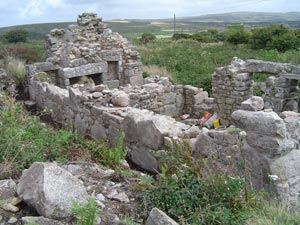
North elevation, looking east towards Mulfra and Castle an Dinas.
Ding Dong mine is reputed to be one of the oldest mines in Cornwall and the area is said to have been worked for tin as far back as Roman times. However the original bounds of Ding Dong from 1782 until 1814 extended approximately from Ishmaels Engine house to Tredinnick Engine house.
A chronology of the mine has been compiled by the recognised historian of Ding Dong Mine, and the Trevithick Society, Gerald Williams and he has confirmed dates quoted.
Rescue Project
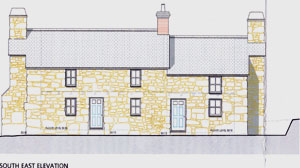
SE Elevation of the Count House
In the mid 1800's the Count House suffered fire damage and was never used again for this purpose and the mine just moved its activities across the road to the New Count House. Today despite many years of disuse this building, which lies within the recently designated Cornish Mining World Heritage Site, is still in a sufficient state of completeness to enable an accurate repair and reinstatement. The aim is to reconstruct The Count House and adjoining cottage exactly as they would have looked in about 1800 and to bring them back to life as a Heritage Centre and Visitor Facility within the World Heritage Site. This objective would also help secure the future of the important Grade 2 listed structure within the curtilage of the buildings. Included would be an interpretation board (there are currently none in the area) detailing the history of the Count House, Ding Dong Mine, Ting Tong Mine, and highlighting the Richard Trevithick connection. It is, of course, this connection that makes the Count House, and the area, of international importance in the development of steam power and the Industrial Revolution.
The Count House is the only surviving building from Richard Trevithick's time as engineer at Ding Dong. It is therefore imperative that this building is saved for posterity for the benefit of future generations and as a tribute to the most famous Cornishman of all... Richard Trevithick.
Finally
Please note that the Count House is privately owned but can be viewed from the nearby road. It is still undergoing structural repairs and therefore, at this time, no public access is permitted.
Acknowledgements
My thanks to the following for their help, advice, encouragement and information: Ken and Pat Wood, Peter Edwards, the late Gerald Beck, Margaret Mann, Peter Noy, Russell Eddy, the late Winnifred Eddy, Philip Care, Elizabeth Luty, widow of Herbert Luty , Chairman of Penwith District Council 1979-81, Eric Berry, Historic Buildings Consultant, Adam Sharpe, Cornwall Council Historic Environment Service, Bryan Earle, Countess Karina Von B. Hosking, Ashley Dunn, Gerald Williams, Historian of Ding Dong Mine and the Trevithick Society, Jan Beare, 'Greasy Gang' member, Joy Wallis, English Heritage, Cornwall Council, Cornwall Records Office and The Trevithick Society.
Scources
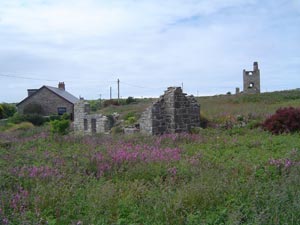
South and East elevations with The New Count House (Trevose) on left, Greenburrow Engine House in background and Ishmaels Whim Engine House on right.
Gerald Williams 1997
Ding Dong-- Its Origin and Early Working.
Ding Dong--A chronology
Francis Trevithick 1872
Life of Richard Trevithick.
Anthony Burton 2000
Richard Trevithick - Giant of Steam
The Mining Journal
Kelly's Directory 1873.
Ding Dong Mine Website entry by The Trevithick Society.
Edith K.Harper 1913
A Cornish Giant.
Cornwall and Scilly Historic Environment Record
Contact Details
I can be contacted at: guy@dingdongcounthouse.org.uk
Links
- The Wheal Buller Project - a similar project restoring the Old Wheal Buller Count House
- The Guitar Collection
